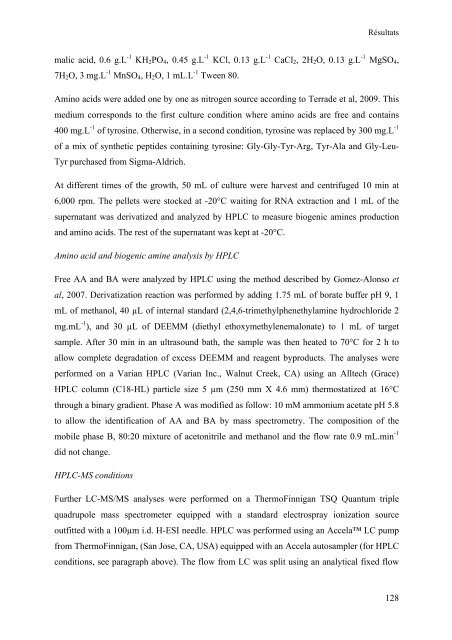THESE Maryse Bonnin Jusserand - Université de Bourgogne
THESE Maryse Bonnin Jusserand - Université de Bourgogne
THESE Maryse Bonnin Jusserand - Université de Bourgogne
You also want an ePaper? Increase the reach of your titles
YUMPU automatically turns print PDFs into web optimized ePapers that Google loves.
Résultats<br />
malic acid, 0.6 g.L -1 KH2PO4, 0.45 g.L -1 KCl, 0.13 g.L -1 CaCl2, 2H2O, 0.13 g.L -1 MgSO4,<br />
7H2O, 3 mg.L -1 MnSO4, H2O, 1 mL.L -1 Tween 80.<br />
Amino acids were ad<strong>de</strong>d one by one as nitrogen source according to Terra<strong>de</strong> et al, 2009. This<br />
medium corresponds to the first culture condition where amino acids are free and contains<br />
400 mg.L -1 of tyrosine. Otherwise, in a second condition, tyrosine was replaced by 300 mg.L -1<br />
of a mix of synthetic pepti<strong>de</strong>s containing tyrosine: Gly-Gly-Tyr-Arg, Tyr-Ala and Gly-Leu-<br />
Tyr purchased from Sigma-Aldrich.<br />
At different times of the growth, 50 mL of culture were harvest and centrifuged 10 min at<br />
6,000 rpm. The pellets were stocked at -20°C waiting for RNA extraction and 1 mL of the<br />
supernatant was <strong>de</strong>rivatized and analyzed by HPLC to measure biogenic amines production<br />
and amino acids. The rest of the supernatant was kept at -20°C.<br />
Amino acid and biogenic amine analysis by HPLC<br />
Free AA and BA were analyzed by HPLC using the method <strong>de</strong>scribed by Gomez-Alonso et<br />
al, 2007. Derivatization reaction was performed by adding 1.75 mL of borate buffer pH 9, 1<br />
mL of methanol, 40 µL of internal standard (2,4,6-trimethylphenethylamine hydrochlori<strong>de</strong> 2<br />
mg.mL -1 ), and 30 µL of DEEMM (diethyl ethoxymethylenemalonate) to 1 mL of target<br />
sample. After 30 min in an ultrasound bath, the sample was then heated to 70°C for 2 h to<br />
allow complete <strong>de</strong>gradation of excess DEEMM and reagent byproducts. The analyses were<br />
performed on a Varian HPLC (Varian Inc., Walnut Creek, CA) using an Alltech (Grace)<br />
HPLC column (C18-HL) particle size 5 µm (250 mm X 4.6 mm) thermostatized at 16°C<br />
through a binary gradient. Phase A was modified as follow: 10 mM ammonium acetate pH 5.8<br />
to allow the i<strong>de</strong>ntification of AA and BA by mass spectrometry. The composition of the<br />
mobile phase B, 80:20 mixture of acetonitrile and methanol and the flow rate 0.9 mL.min -1<br />
did not change.<br />
HPLC-MS conditions<br />
Further LC-MS/MS analyses were performed on a ThermoFinnigan TSQ Quantum triple<br />
quadrupole mass spectrometer equipped with a standard electrospray ionization source<br />
outfitted with a 100µm i.d. H-ESI needle. HPLC was performed using an Accela LC pump<br />
from ThermoFinnigan, (San Jose, CA, USA) equipped with an Accela autosampler (for HPLC<br />
conditions, see paragraph above). The flow from LC was split using an analytical fixed flow<br />
128

















